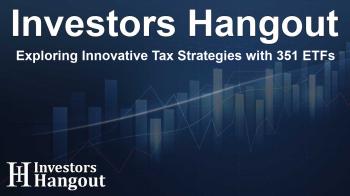Exploring Innovative Tax Strategies with 351 ETFs

Understanding the 351 ETF Framework
Imagine the challenge faced by shareholders of companies like Nvidia (NASDAQ: NVDA) holding substantial unrealized profits. While these individuals enjoy phenomenal returns, they also face a daunting tax bill upon selling their shares.
In recent discussions, it has come to light that affluent individuals and certain institutions are ingeniously leveraging a tax provision dating back to a century ago to sidestep taxes on enormous unrealized gains. Enter the 351 ETFs, which uniquely begin with substantial assets instead of minimal cash. In essence, these ETFs comprise assets that have experienced significant appreciation, thus harboring substantial unrealized tax gains.
The term '351' derives from section 351 of the U.S. tax code, established in 1924. This regulation enables the non-recognition of any gains or losses when property is transferred to a corporation in exchange for stock, contingent upon the transferor retaining at least 80% of the new stock issued.
Although the tax code has undergone several modifications since its inception, the defining feature of 351 ETFs lies in their ability for almost anyone to transfer stock into an ETF, subsequently evading capital gains taxes. This means that after investors shift their assets into a 351 ETF, they can sell those stocks, replace them with different assets, and reap significant profits without incurring tax liabilities.
However, there is a catch: the entity holding the majority of shares is responsible for the costs involved with establishing and operating the 351 ETF, along with fiduciary management responsibilities.
Current Trends in Meme Stocks
Shifting gears to a different but equally intriguing subject, let's examine the latest dynamics influencing meme stocks, specifically those surrounding retailer Kohl’s (NYSE: KSS). Recently, shares of Kohl’s saw their prices double when the market opened, indicating a rise in interest likely fueled by social media discussions.
On a particular Monday, Kohl’s stock closed at $10.50, but by Tuesday morning, it jumped to $21.50. This spike represents a fascinating trend of digital engagement significantly impacting stock values.
In recent months, a noticeable trend has emerged where speculative stock activities are becoming prevalent. Numerous stocks associated with innovations like AI and cryptocurrency are witnessing spectacular rallies. Additionally, options with a brief time frame are garnering renewed popularity, aligning with the surging interest in meme stocks like Kohl’s, which exhibit extreme volatility despite the absence of concrete news to justify such movements.
Notably, Kohl's short interest was recorded at nearly 50%. Thus, if enthusiasts driving meme stocks manage to push the prices higher, it could trigger substantial buying activity among those with short positions. This reaction appears to have been a key driver behind the price surge observed on that Tuesday.
The Future of 351 ETFs and Meme Stocks
The innovative approach of 351 ETFs represents a strategic move for investors seeking to manage tax liabilities effectively. As more individuals learn about these investment vehicles, we might witness a growing trend of their adoption, enhancing their visibility within the investment community.
Moreover, as we continue to see stocks like Kohl's engaging in extreme fluctuations driven by social media sentiment, it raises questions about the long-term sustainability of such investment strategies. Investors should ponder whether these trends are a temporary phenomenon or if they will evolve into a stable method of trading.
Conclusion
In this evolving landscape of investment strategies, the 351 ETF may redefine how investors approach taxes on unrealized gains, while stocks like Kohl's could alter perceptions regarding meme trading. As discussions surrounding these topics grow, individuals looking to maximize their investment potential must remain vigilant and adaptable to this dynamic market.
Frequently Asked Questions
What are 351 ETFs?
351 ETFs are investment vehicles that leverage a century-old tax provision allowing investors to transfer assets and avoid capital gains taxes upon selling.
How does section 351 of the tax code work?
This section allows non-recognition of gains when property is exchanged for stock, provided the transferor retains at least 80% of the shares.
What costs are associated with managing a 351 ETF?
The majority shareholder is responsible for the setup, operational fees, and fiduciary management of the ETF.
Why are meme stocks becoming popular?
Meme stocks, such as Kohl’s, gained popularity due to social media influence, often resulting in rapid price changes driven by retail investor sentiment.
What impacts the volatility of meme stocks?
Factors such as short interest, speculative trading, and social media engagement significantly affect the volatility observed in meme stocks.
About The Author
Contact Kelly Martin privately here. Or send an email with ATTN: Kelly Martin as the subject to contact@investorshangout.com.
About Investors Hangout
Investors Hangout is a leading online stock forum for financial discussion and learning, offering a wide range of free tools and resources. It draws in traders of all levels, who exchange market knowledge, investigate trading tactics, and keep an eye on industry developments in real time. Featuring financial articles, stock message boards, quotes, charts, company profiles, and live news updates. Through cooperative learning and a wealth of informational resources, it helps users from novices creating their first portfolios to experts honing their techniques. Join Investors Hangout today: https://investorshangout.com/
The content of this article is based on factual, publicly available information and does not represent legal, financial, or investment advice. Investors Hangout does not offer financial advice, and the author is not a licensed financial advisor. Consult a qualified advisor before making any financial or investment decisions based on this article. This article should not be considered advice to purchase, sell, or hold any securities or other investments. If any of the material provided here is inaccurate, please contact us for corrections.

